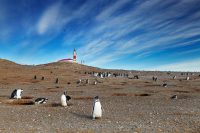Patagonia is the adventure playground of South America, and tourists flock here for its blend of extraordinary flora and fauna and superlatively tall mountains that are just begging to be hiked.
But as a “once in a lifetime” destination, you want to make sure that you squeeze every last moment out of your holiday. To do so, follow these indispensable tips for ensuring that your adventures are extraordinary and your memories of Patagonia unforgettable.
1. Learn the lingo – or find a phrase book
While many of the larger cities are filled with multi-lingual Patagonians keen to practice their English, rural areas are less promising for those without previous Spanish knowledge. But don’t let this put you off. A couple of pre-departure Spanish classes, or just a trusty old phrase book and buckets of enthusiasm can get you through most language situations. It’s said that Patagonians are the friendliest people of Argentina and Chile and they’re always delighted by tourists having a crack at the local castellano.
2. Don’t get surprised by the seasons
 The summer period from November through to February is generally lauded as the best season to travel in Patagonia.
The summer period from November through to February is generally lauded as the best season to travel in Patagonia.
That said, the shoulder seasons (September/October and March/April) mean fewer tourists and even more beautiful weather, as autumn flecks Patagonian forests with golden hues and skies are brilliant and cloudless. Discounts for tours and general travel are often available during this period too.
3. Pack well – and for every eventuality
Even if visiting Patagonia in the height of summer, the climatic range between low grasslands in the Argentine pampas and alpine mountains along the Andes chain, means travelers should always come prepared to face every weather possibility. A warm fleece, waterproof coat and multiple layers for sun, snow and anything in between, should form the bulk of your luggage and a decent pair of walking boots will definitely be appreciated. Hiking poles will become immediately indispensable when you start walking, while sunblock and a wide-brimmed hat will protect from the harsh rays of the South American sun.
A pair of binoculars if you’re hoping to spot a colorful Magellanic woodpecker or endangered huemul deer are essentials, as is a camera with an excellent lens for capturing your close encounters with cougars or singing King penguins.
4. Don’t get caught out with your cash
Patagonia has a reputation for being a hard place for finding a working ATM – or one that will accept your credit card. While the central hubs of Coyhaique, Bariloche, El Calafate, Punta Arenas and Ushuaia shouldn’t provide too many problems, if heading off into more rural parts, it’s best to be prepared. Take out currency in Buenos Aires or Santiago before heading south, or bring US dollars to exchange on location so that you avoid getting caught out.

5. Plan around Patagonia’s vast size
Spanning an area four times the size of the United Kingdom, Patagonia isn’t small, and travelers looking to explore have two options: dedicate themselves to one region, or fly. Although the actual boundaries are disputed, from Bariloche on the northern edge of Argentine Patagonia, to Ushuaia at the very southern tip, it’s a whopping 1,300-miles (2,161 km).
Luckily, a decent network of buses cover this distance, and planes from Santiago and Buenos Aires fly to Patagonian cities such as Punta Arenas, Bariloche, El Calafate and Ushuaia.
6. Book in advance – or bring a tent
As Patagonia’s international fame as a tantalizing destination for the intrepid traveler has grown, visitor numbers have similarly swelled. And while this means that standards of accommodation, food and tours have gone through the roof, it also signifies that travelers need to plan ahead if they want to bag the best options.
 During the summer, accommodations can get completely booked up, so organizing this a couple of months in advance is highly recommended. If you want more flexibility in your itinerary, consider hiring a rental 4×4 and driving Chile’s Carretera Austral or Argentina’s Ruta Nacional 40. Bring a tent to make the most of the numerous wild camping locations that you stumble across and which don’t need to be booked in advance.
During the summer, accommodations can get completely booked up, so organizing this a couple of months in advance is highly recommended. If you want more flexibility in your itinerary, consider hiring a rental 4×4 and driving Chile’s Carretera Austral or Argentina’s Ruta Nacional 40. Bring a tent to make the most of the numerous wild camping locations that you stumble across and which don’t need to be booked in advance.
No comments yet
There are no comments on this post yet.






Leave a comment